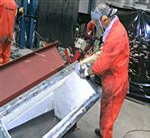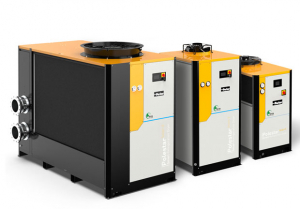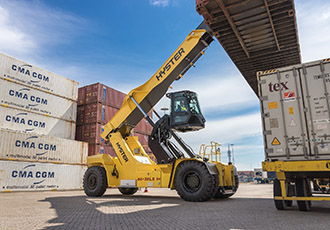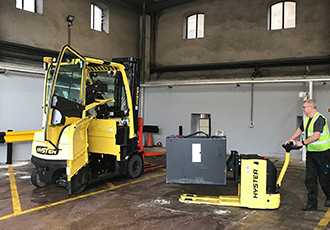WEAR PROTECTION UNDERWRITES CONTINUITY OF PRODUCTION & SUPPLY, DELIVERING OPTIMUM ROI IN DEMANDING ANIMAL FEED MARKET
15th June 2011
Source:
Kingfisher Industrial Ltd

The global demand for animal feeds has never been higher, fuelled by increasing heavy consumption of meat in China and wealthy countries in the ASEAN block. This demand means that continuity of supply is all important placing stress all along the supply chain, from processing and transferring of raw materials and finished product in animal feed plants, to handling, conveying and storing the product at ports for onward shipping.
Handling solid and liquid ingredients together with binding agents makes the whole process of producing animal feed an activity where success depends on the equipment remaining reliable, 24-hrs a day. However, militating against this is the nature of animal feeds themselves. The operations of processing, mixing, blending, conveying and transferring bring large volumes of semi-aggressive media into contact with a variety of plant surfaces. This media has the capability to wear out hoppers, feeders, chutes and mixing equipment very quickly, resulting in lost production and excessive maintenance costs.
Whether the feed is conveyed as dried, mixed or packaged, the process creates wear problems. Depending on the volumes and the operational regime, these will significantly reduce the value of the processing company’s capital equipment if the plant is not wear protected for continual operation. Constant wear, leading to frequent repairs and maintenance can be avoided if the correct wear protection is applied. The result is drastically reduced cost of repairs on worn-out chutes, ruptured pipelines, crumbling silos and conveyors.
Eliminating these on-going wear and repair concerns enables the process to operate as designed, maximising its efficiency and the operational team’s resource capability allowing production efficiency improvement and improved ROI in the animal feed processing business.
In common with other bulk materials handling industries, the equipment for processing and conveying animal feeds needs to cater for many operational factors. If considered from the onset, these factors can be catered for and a design element introduced to compensate for potential wear problems.
Factors such as volumes, loadings, particle size and shape, viscosity and moisture content are typical criteria that must be addressed in order to eliminate potential problem wear areas. Selecting the right liner materials, hopper design and pipe installation can prevent the need for replacement and maintenance for up to 20- years.
“No maintenance requirements over the lifetime of an installation means reduced risk, reduced cost and more production uptime over longer periods – all of which are critically important to improve the efficiencies of companies that operate 24/7,”said John Connolly, MD of UK wear protection specialist, Kingfisher Industrial.
In quantitative terms the benefits to the plant user are huge, because maintenance of process plant and equipment is a complex and multi-layered operation. Avoided are the ongoing cost problems of interruptions to production as a result of breaking down pipework; the requirement for specialist labour, and the safety risks involved with personnel working at height, performing hot work and lifting operations. In addition, the tasks of organising access platforms and plant hire, with their attendant costs – and risks – are no longer necessary; nor are procedures devised for the cleaning- up of spillages that may occur when process pipework is perforated, thus creating an environmental issue or potential breach of legislation. As a result, the system user benefits from continuous operational gains which defray the cost of the protection system, guaranteeing a prompt return on investment.
Using a combination of ceramic, metallic and polymer lining systems, Kingfisher has had overwhelming success in protecting equipment and extending the service life of bulk materials handling plant. In many instances, the benefits of protecting plant are threefold: in addition to protecting against wear, the low friction nature of the lining material reduces energy usage and increases production by allowing a greater volume of material to be throughput.
“A major benefit of wear protection is that it can be employed at any time in the life of a process system, so users do not have to throw away their existing plant and start again,” said John Connolly. “In addition, because high conveying speeds and abrasive materials cause wear of varying intensity at different points in process plant systems, it is often the case that protection need only be applied to areas that are most vulnerable to wear, further reducing upfront costs and improving ROI for the system user.”
Whether the feed is conveyed as dried, mixed or packaged, the process creates wear problems. Depending on the volumes and the operational regime, these will significantly reduce the value of the processing company’s capital equipment if the plant is not wear protected for continual operation. Constant wear, leading to frequent repairs and maintenance can be avoided if the correct wear protection is applied. The result is drastically reduced cost of repairs on worn-out chutes, ruptured pipelines, crumbling silos and conveyors.
Eliminating these on-going wear and repair concerns enables the process to operate as designed, maximising its efficiency and the operational team’s resource capability allowing production efficiency improvement and improved ROI in the animal feed processing business.
In common with other bulk materials handling industries, the equipment for processing and conveying animal feeds needs to cater for many operational factors. If considered from the onset, these factors can be catered for and a design element introduced to compensate for potential wear problems.
Factors such as volumes, loadings, particle size and shape, viscosity and moisture content are typical criteria that must be addressed in order to eliminate potential problem wear areas. Selecting the right liner materials, hopper design and pipe installation can prevent the need for replacement and maintenance for up to 20- years.
“No maintenance requirements over the lifetime of an installation means reduced risk, reduced cost and more production uptime over longer periods – all of which are critically important to improve the efficiencies of companies that operate 24/7,”said John Connolly, MD of UK wear protection specialist, Kingfisher Industrial.
In quantitative terms the benefits to the plant user are huge, because maintenance of process plant and equipment is a complex and multi-layered operation. Avoided are the ongoing cost problems of interruptions to production as a result of breaking down pipework; the requirement for specialist labour, and the safety risks involved with personnel working at height, performing hot work and lifting operations. In addition, the tasks of organising access platforms and plant hire, with their attendant costs – and risks – are no longer necessary; nor are procedures devised for the cleaning- up of spillages that may occur when process pipework is perforated, thus creating an environmental issue or potential breach of legislation. As a result, the system user benefits from continuous operational gains which defray the cost of the protection system, guaranteeing a prompt return on investment.
Using a combination of ceramic, metallic and polymer lining systems, Kingfisher has had overwhelming success in protecting equipment and extending the service life of bulk materials handling plant. In many instances, the benefits of protecting plant are threefold: in addition to protecting against wear, the low friction nature of the lining material reduces energy usage and increases production by allowing a greater volume of material to be throughput.
“A major benefit of wear protection is that it can be employed at any time in the life of a process system, so users do not have to throw away their existing plant and start again,” said John Connolly. “In addition, because high conveying speeds and abrasive materials cause wear of varying intensity at different points in process plant systems, it is often the case that protection need only be applied to areas that are most vulnerable to wear, further reducing upfront costs and improving ROI for the system user.”
Similar articles
More from Kingfisher Industrial Ltd
- Polyethylene piping has abrasion resistant lining 3rd December 2012
- Kingfisher demonstrates reduced maintenance costs and improved operational availability using latest wear protection techniques at RWM 28th August 2012
- Hillhead 2012 was bigger & better for Kingfisher! 24th July 2012
- Wear Protection Systems Deliver Longevity To Quarry Feeding, Conveying & Storage Plant 19th June 2012




.jpg)







Write a comment
No comments